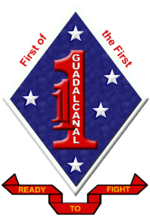1st Battalion 1st Marines
| 1st Battalion 1st Marines | |
|---|---|

1/1 Insignia
|
|
| Active |
|
| Country | United States |
| Branch | USMC |
| Type | Battalion landing team |
| Role | Locate, close with and destroy the enemy by fire and maneuver |
| Size | 1,200 |
| Part of |
1st Marine Regiment 1st Marine Division |
| Garrison/HQ | Marine Corps Base Camp Pendleton |
| Nickname(s) | "First of the First" |
| Motto(s) | "Ready to Fight" "Right Of Line.First Of Foot" |
| Engagements |
World War II *Guadalcanal Campaign *Battle of Cape Gloucester *Battle of Peleliu *Battle of Okinawa Korean War *Battle of Inchon *Battle of Chosin Reservoir Vietnam War *Operation Union *Battle of Hue Operation Desert Storm Operation Enduring Freedom Operation Iraqi Freedom *2003 invasion of Iraq *Operation Phantom Fury |
| Commanders | |
| Current commander |
Lieutenant Colonel Daniel W. Mickilis |
1st Battalion 1st Marines (1/1) is an infantry battalion in the United States Marine Corps based out of Camp Pendleton, California consisting of anywhere from 800 to 2,000 Marines and Sailors, but the number fluctuates depending on the Battalion's mission. They fall under the command of the 1st Marine Regiment and the 1st Marine Division.
1/1 is a battalion-level infantry unit composed of infantry Marines and support personnel.
The battalion has been organized around fire and maneuver warfare in tropical, woodland, desert, or Arctic environments. From at least 1989, the units were organized as such:
Since 2003, after the fall of Saddam Hussein's government, the strategic operations in the Middle East (Iraq, Afghanistan) have encompassed more than just a single objective. For Marine Corps units operating on a tactical level (relative to the Department of Defense) such as a battalion landing team, the actual execution of its traditional mission-oriented operations have adapted depending on the unit's objective (capturing high-value targets, providing stability and support operations, training local police and military units, and a three block war). Some of these operations have demanded reconfiguring the battalion's organization in order to conduct missions which are not included in traditional maneuver warfare (such as fire-team rushing, and anti-armor tactics).
Military transition teams (MiT teams) have been used to provide assistance for the transition of power from the coalition forces to the local police and army in Iraq. While these MiT teams would draw personnel from other companies, Marines for other part of the division would often rotate into the battalion for a deployment in order to supplement the various companies' rosters.
...
Wikipedia
